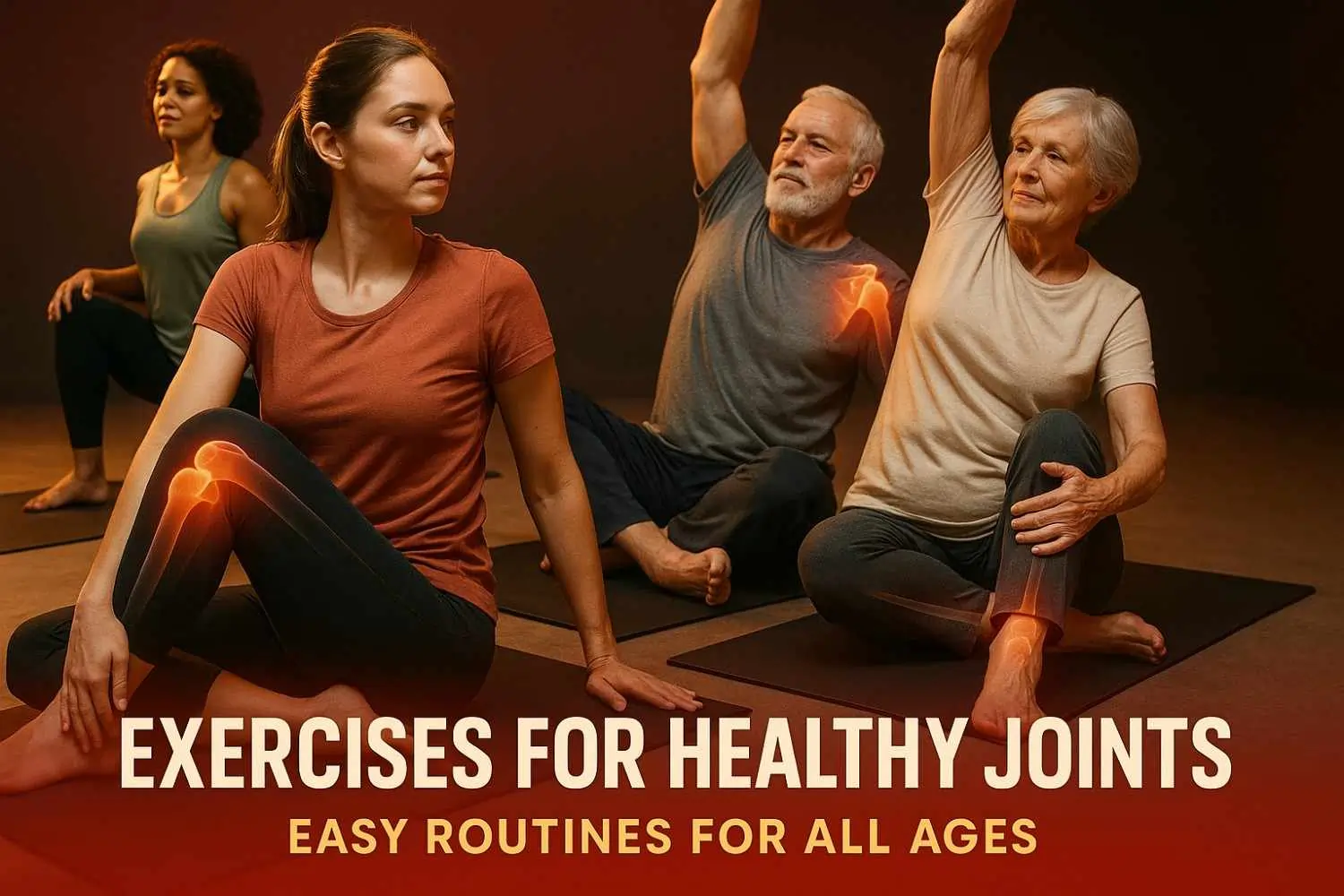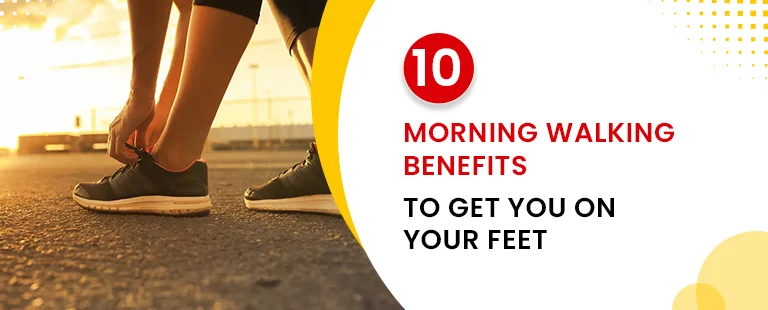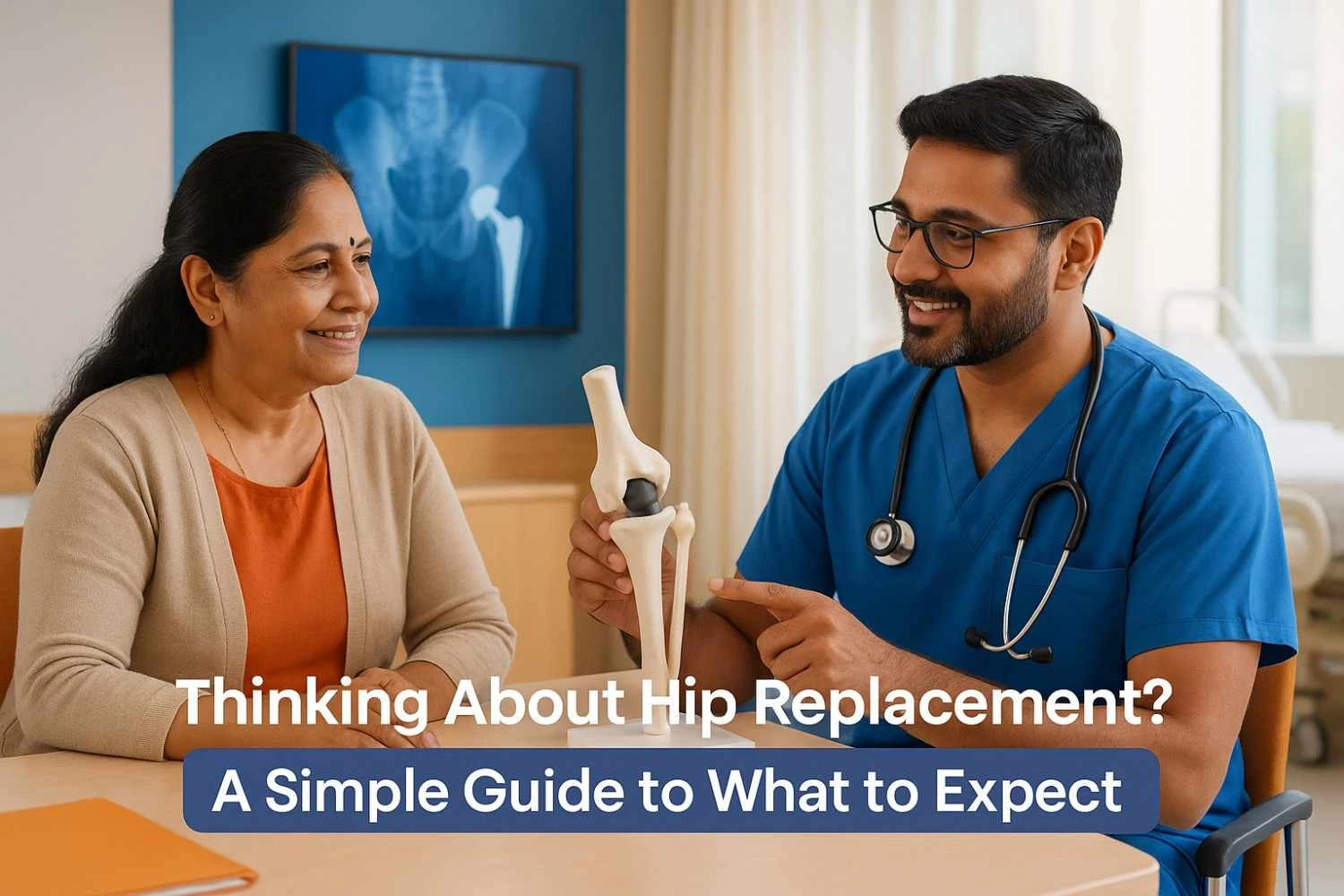Joint health exercises are specific physical activities designed to strengthen the muscles around your joints, improve flexibility, and maintain a full range of motion. This helps reduce pain, prevent injury, and ensure you stay active and mobile for life.
Do your knees complain when you climb stairs? Do your shoulders feel stiff in the morning? You're not alone. Joint pain is a common issue that affects people of all ages, from young adults to seniors. Many people in India believe that exercise wears out the joints, but at Germanten Hospitals, we know the opposite is true. Movement is medicine.
Regular, gentle exercise is the single most powerful thing you can do to protect your joints, reduce stiffness, and live a pain-free life. Whether you are in your 20s and want to prevent future problems or in your 60s and looking to improve mobility, this guide is for you.
As a leading orthopedic hospital in Hyderabad, we have helped thousands of patients reclaim their mobility. This comprehensive guide, created by our expert orthopedic team, will show you simple, effective exercises to keep your joints healthy and strong at every stage of life.
Why Movement is the Best Medicine for Your Joints
It’s a common myth that resting your joints is the best way to protect them. While rest is crucial after an injury, a lack of regular movement can actually make joint stiffness and pain worse. Here’s why your joints need you to move.
The Myth of "Wearing Out" Your Joints
Think of your joints like the engine of a car. If you leave a car sitting in the garage for months, the engine parts can seize up. Your joints are similar. They are designed for movement.
Inside each joint is a special substance called synovial fluid. This fluid acts like engine oil, lubricating the cartilage (the smooth, protective tissue on the ends of your bones) and delivering essential nutrients to keep it healthy. Movement is what pumps this fluid around the joint, ensuring the cartilage stays nourished and slippery. When you are inactive, this fluid becomes stagnant, and the cartilage can begin to degrade.
How Exercise Builds a Natural Brace for Your Joints
The muscles, ligaments, and tendons surrounding your joints act as a dynamic support system. When these muscles are strong, they absorb the shock and stress of daily activities like walking, lifting, and climbing.
According to a 2024 study, even a small increase in the strength of your thigh muscles (quadriceps) can significantly reduce the risk of developing knee osteoarthritis. Strong muscles hold your joints in proper alignment, preventing the tiny, damaging micro-movements that lead to long-term wear and tear.
The 3 Pillars of a Joint-Friendly Exercise Plan
A balanced exercise routine for joint health isn't about one single activity. It’s about combining three essential types of exercise. Each pillar supports the others, creating a powerful, holistic program for lifelong joint resilience.
Pillar 1: Low-Impact Cardio (The Engine)
Low-impact cardiovascular exercises get your heart rate up without putting jarring stress on your joints. These activities are crucial for managing weight (less weight means less pressure on your knees and hips), improving circulation, and boosting your overall energy.
- Walking: The most accessible exercise. Aim for at least 150 minutes of brisk walking per week.
- Cycling: Whether outdoors or on a stationary bike, cycling is a non-weight-bearing activity that’s excellent for strengthening leg muscles without straining the knees.
- Swimming & Water Aerobics: The buoyancy of water supports your body weight, making it the ultimate joint-friendly workout. The water provides gentle resistance to strengthen muscles all over your body.
- Elliptical Trainer: This machine mimics the motion of running but without the impact, making it a safe and effective option.
Pillar 2: Strength Training (The Bodyguard)
Strength training is non-negotiable for joint health. It builds the muscles that act as your body's natural shock absorbers. You don’t need to lift heavy weights; you can use your own body weight, resistance bands, or light dumbbells.
- Focus on Form: Proper technique is more important than the amount of weight you lift. Move slowly and with control.
- Don't Lock Your Joints: Avoid fully straightening your knees or elbows at the end of a movement, as this puts stress directly on the joint.
- Rest is Key: Strength train 2-3 times per week on non-consecutive days to allow your muscles time to recover and grow stronger.
Pillar 3: Flexibility & Mobility (The Lubricant)
Flexibility exercises ensure your joints can move through their full, intended range of motion without pain or stiffness. This is vital for performing daily tasks and preventing injuries. For older adults, good flexibility and balance are critical for preventing falls.
- Stretching: Gentle stretching helps relieve stiffness and improve mobility. It’s best done after your muscles are warm, like at the end of a workout.
- Yoga & Tai Chi: These mind-body practices are fantastic for joint health because they combine strength, balance, and flexibility in a low-impact way. Studies have shown Tai Chi can significantly improve pain and mobility for people with knee osteoarthritis.
Getting Started: The Non-Negotiable Warm-Up and Cool-Down
Never jump straight into a workout, and don't stop abruptly. A proper warm-up and cool-down are essential for protecting your joints, preventing injury, and getting the most out of your exercise session.
Your 10-Minute Dynamic Warm-Up Routine
A dynamic warm-up uses active movements to prepare your body for exercise. It increases blood flow, warms up your muscles, and lubricates your joints. Perform these movements for about 10 minutes before every workout.
- Arm Circles: Stand with arms out to your sides. Make 20 small circles forward, then 20 backward. Gradually make the circles bigger.
- Leg Swings: Hold onto a wall or chair for support. Swing one leg forward and backward 15-20 times in a smooth, controlled motion. Then, face the wall and swing the leg side-to-side 15-20 times. Repeat with the other leg.
- Hip Circles: Standing on one leg, lift the other knee and gently make circles out to the side. Do 10 circles in each direction, then switch legs.
- Walking High Knees: As you walk forward, bring one knee up towards your chest. Alternate legs for 30 seconds.
- Torso Twists: Stand with feet shoulder-width apart and knees slightly bent. Gently twist your upper body from side to side for 30 seconds.
Your 10-Minute Cool-Down with Static Stretches
A cool-down helps your heart rate return to normal and improves long-term flexibility. Static stretching (holding a stretch) is most effective when your muscles are warm. Hold each stretch for 30 seconds. Never stretch to the point of sharp pain.
- Standing Quadriceps Stretch: Hold onto a wall for balance. Grab your right ankle and gently pull your heel toward your glute. Keep your knees together. Hold, then switch legs.
- Hamstring Stretch: Sit on the edge of a chair. Extend one leg straight out in front of you with the heel on the floor. Keeping your back straight, gently lean forward from your hips until you feel a stretch in the back of your thigh. Hold, then switch legs.
- Calf Stretch: Stand facing a wall with your hands on it for support. Step one foot back, keeping the leg straight and the heel on the floor. Bend your front knee until you feel a stretch in the calf of your back leg. Hold, then switch legs.
- Knee-to-Chest Stretch: Lie on your back. Gently pull one knee toward your chest, holding it with both hands. Keep your other leg relaxed on the floor. Hold, then switch legs.
- Cross-Body Shoulder Stretch: Bring one arm straight across your chest. Use your other hand to gently pull it closer to your body until you feel a stretch in your shoulder. Hold, then switch arms.
Tailoring Exercises for Every Stage of Life
Joint health needs change as we age. A 25-year-old has different needs than a 65-year-old. Here’s how to adapt your routine for every decade.
For Young Adults (20s-30s): Building a Strong Foundation
This is the time to build a "bone and muscle bank" for the future. The focus is on prevention and creating a resilient body.
- Strength Training: Focus on compound exercises like body-weight squats, lunges, and push-ups with perfect form. Aim for 2-3 sessions per week.
- Cardio: Mix low-impact activities like cycling with moderate amounts of higher-impact activities like jogging or sports, as long as you have no prior injuries. This balance helps build strong bones and a healthy heart.
- Flexibility: Don't skip the post-workout stretch! Counteract the effects of sitting at a desk all day by maintaining your flexibility.
For Middle-Aged Adults (40s-50s): Maintenance and Mitigation
The focus shifts to maintaining muscle mass and managing the first signs of wear and tear.
- Strength Training: This is now essential to fight age-related muscle loss. Continue with compound movements 2-3 times a week, but be ready to reduce weight or modify exercises if you feel pain.
- Cardio: Prioritize low-impact options. Make swimming, cycling, and the elliptical the core of your cardio routine. Varying your activities (cross-training) prevents repetitive stress on one joint.
- Mobility: Daily stretching is crucial to combat stiffness. This is the time to try yoga or Pilates to integrate strength, balance, and flexibility.
For Seniors (60+): Prioritizing Mobility, Balance, and Independence
The primary goals are maintaining daily function, managing conditions like arthritis, and preventing falls. Exercises should be gentle and build confidence.
- Chair-Based Strength Training: Many
exercises can be done safely from a chair.
- Chair Squats: Stand in front of a sturdy chair. Slowly lower yourself until you lightly touch the seat, then stand back up. Use your hands for support if needed.
- Seated Leg Lifts: Sit tall in a chair and slowly extend one leg straight out. Hold for a few seconds, then lower. This strengthens the thigh muscles that support the knee.
- Wall Push-Ups: Stand facing a wall and place your hands on it. Slowly bend your elbows to bring your chest toward the wall, then push back.
- Balance Exercises: These are vital for
fall prevention.
- Single-Leg Stand: Hold onto a sturdy chair or counter. Lift one foot off the floor and hold for 10-20 seconds. As you improve, try holding on with just one finger, then not at all.
- Heel-to-Toe Walk: Walk in a straight line, placing the heel of one foot directly in front of the toes of the other.
- Gentle Cardio: Walking and water aerobics are the gold standard. They provide excellent cardiovascular benefits with minimal stress on the joints.
Sample Weekly Workout Plan for Healthy Joints
Here is a balanced, sample schedule that integrates all three pillars. Remember to perform a dynamic warm-up before each session and a static cool-down afterward.
| Day | Activity Focus | Specific Workout | Duration | Notes |
|---|---|---|---|---|
| Monday | Strength (Full Body A) | 3 sets of 10-12 reps: Chair Squats, Wall Push-Ups, Seated Rows with bands, Elbow Plank. | 30-40 mins | Focus on slow, controlled movements. |
| Tuesday | Moderate Cardio | 30-45 minutes of continuous cycling or swimming. | 30-45 mins | Maintain a steady, conversational pace. |
| Wednesday | Active Recovery | 20-minute gentle walk followed by a 15-minute full-body stretching session or a gentle yoga class. | 35 mins | Promotes blood flow and reduces stiffness. |
| Thursday | Strength (Full Body B) | 3 sets of 10-12 reps: Glute Bridges, Static Lunges (holding a chair), Bicep Curls (light weights). | 30-40 mins | Work different muscles than on Monday. |
| Friday | Moderate Cardio | 30-45 minutes on the elliptical or a water aerobics class. | 30-45 mins | Cross-training prevents repetitive stress. |
| Saturday | Active Recreation | 60+ minutes of an enjoyable activity like gardening, dancing, or a long walk in a park. | 60+ mins | Movement should be fun to ensure consistency. |
| Sunday | Rest | Complete rest or very light stretching (e.g., shoulder rolls, ankle circles). | - | Allow your body to fully recover and repair. |
Safety First: How to Listen to Your Body and Avoid Injury
Exercise should make you feel better, not worse. Learning to understand your body's signals is the key to a safe and sustainable fitness journey.
Why 'No Pain, No Gain' is Terrible Advice for Joint Health
The old fitness mantra of "no pain, no gain" is dangerous when it comes to joint health. It's crucial to distinguish between the normal muscle soreness that comes from a good workout and the "bad pain" that signals a problem.
- Good Pain: A mild, achy feeling in your muscles 24-48 hours after a workout. This is a sign your muscles are adapting and getting stronger.
- Bad Pain: Sharp, stabbing, or shooting pain in a joint during exercise. This is a red flag. Pain that gets worse as you continue an activity or causes visible swelling, warmth, or redness is also a warning sign.
If you experience "bad pain," stop the activity immediately. Rest and apply ice if needed. If the pain doesn't go away after a few days of rest, it's time to seek professional advice.
When to Seek an Orthopaedic Consultation in Hyderabad
While this guide provides a great starting point, self-managing persistent pain can be risky. You should schedule an orthopaedic consultation in Hyderabad if you experience:
- Joint pain that lasts for more than a few days and doesn't improve with rest.
- Pain that gets progressively worse or wakes you up at night.
- A sudden decrease in your joint's range of motion (e.g., you can't fully straighten your knee).
- Visible swelling, redness, or instability in a joint.
- Difficulty performing simple daily activities due to joint pain.
Searching for an "orthopedic clinic near me hyderabad" can be overwhelming. It's important to choose a facility with a team of experienced specialists. At Germanten, the best orthopedic hospital Hyderabad has to offer, our team uses advanced diagnostics to identify the root cause of your pain and create a personalized treatment plan. Our goal is to get you moving again, safely and effectively.
Your Path to Lifelong Mobility Starts Today
Protecting your joints is one of the best investments you can make in your long-term health and independence. A balanced routine of low-impact cardio, strength training, and flexibility work is a powerful, evidence-based strategy for people of all ages.
Start slowly, listen to your body, and be consistent. The journey to healthy joints isn't about intense, punishing workouts; it's about making gentle, intelligent movement a part of your daily life.
Ready to take control of your joint health? If you're experiencing persistent pain or want expert guidance on the right exercise plan for you, don't wait. Schedule a consultation with the best orthopedic doctor in Attapur and the wider Hyderabad region at Germanten Hospitals. Let us help you move better and live better.




